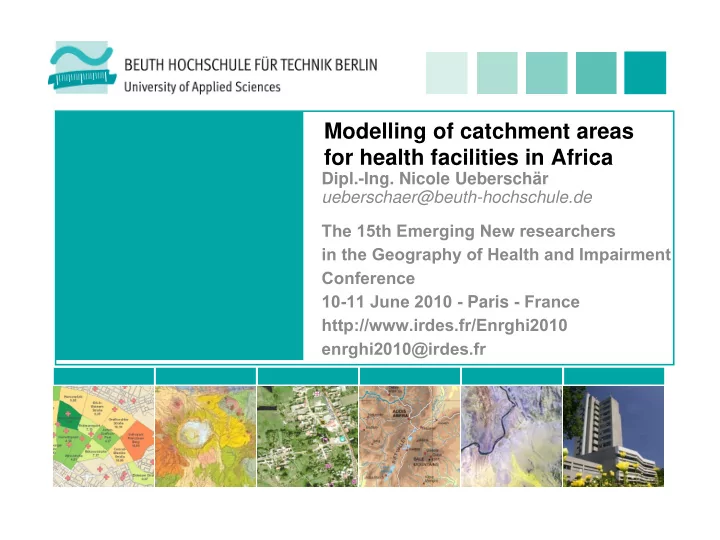

Modelling of catchment areas for health facilities in Africa Dipl.-Ing. Nicole Ueberschär ueberschaer@beuth-hochschule.de The 15th Emerging New researchers in the Geography of Health and Impairment Conference 10-11 June 2010 - Paris - France http://www.irdes.fr/Enrghi2010 enrghi2010@irdes.fr
Outline � Introduction � Examples from South Africa and Kenya � Application on Rwanda � Difficulties/Limitations � Findings � Further steps 2
Introduction � Health Management Information System (HMIS) in Rwanda: data on health centre level � Estimation of catchment areas (in general 5 km or one hour by foot) � Ability of estimating population to be served 3
Examples from South Africa and Kenya � Tanser, F., Gijsbertsen B. & K. Herbst (2006): Modelling and understanding primary health care accessibility and utilization in rural South Africa: An exploration using a geographical information system. Social Science & Medicine, 63: 691-705. � Noor, A.M., Amin, A.A., Gething, P.W., Atkinson, P.M., Hay, S.I. & R.W. Snow (2006): Modelling distances travelled to government health services in Kenya. Tropical Medicine and International Health 11, no. 2: 188-196. 4
Example from South Africa � Public transport model (network) & walking model (Euclidean distances) � Proportion of homesteads using public transport � Quality and distribution of road network � Barriers (perennial rivers, nature reserves) � Reported travel times � Limitations: � No further topography considered, average usage of public transport, assumed equally spread coverage of public transport � 91% of clinic usage predictable 5
Example form South Africa Tanser et al. (2006) 6
Example from Kenya � Walking model for travel time � Transport network with travel speed by foot based on Langmuir (1984) � Topography � Natural barriers � Population density � Choice between different types of facilities � Competition-adjusted transport network: overall accuracy of 84% 7
Example from Kenya Noor et al. (2006) 8
Application on Rwanda � Unclear how population to be served is estimated (5 km or one hour by foot) � Geographical coordinates of health facilities (GPS) � Aggregated data available about origin of patients (zone, out of zone, out of district) on health facilities level 9
Origin of patients ? 10
Application on Rwanda � Buffer zones in ? 2500m and 5000m distance � gives the impression of missing health ? centres (or missing data) 11
Application on Rwanda 12
Difficulties/Limitations � Incomplete coordinates for health centres � Incomplete road’s data � Wrong/inconsistent data (roads, health centres, geometry and data) � Data about origin of patients is available only aggregated 13
Findings � Patients are coming from other zones than the assumed catchment areas (5-30%) � Euclidean distances have been proved to underestimate travel time in Kenya � Network analysis proved to give better results in South Africa → until now limitations in Rwanda 14
Further steps � Retrospective data of origin of patients � Fieldwork in health centres will give an idea of travel time, means and cost of travelling as well as reasons for choosing a certain health centre � Consideration of results from fieldwork as well as barriers (water, elevation) for modelling � Development of a “weighting system” � Downscaling of population and calculation for catchment areas 15
Acknowlegdements � Centre for Geographical Information Systems and Remote Sensing at the National University of Rwanda (CGIS-NUR) � Ministry of Health Rwanda 16
Thank you for your attention!
Recommend
More recommend